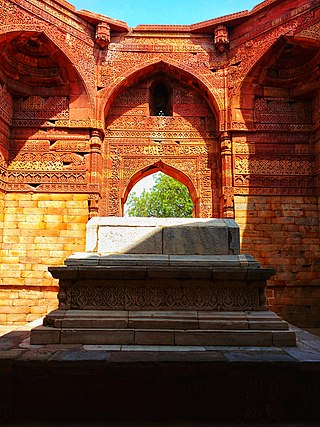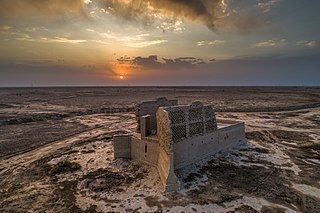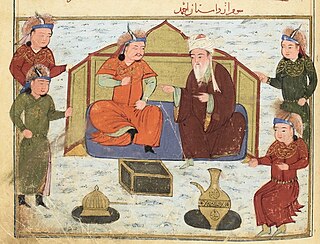Related Research Articles

Ahmad Senjer was the Seljuq ruler of Khorasan from 1097 until in 1118, when he became the Sultan of the Seljuq Empire, which he ruled until his death in 1157.

Shams ud-Din Iltutmish was the third of the Mamluk kings who ruled the former Ghurid territories in northern India. He was the first Muslim sovereign to rule from Delhi, and is thus considered the effective founder of the Delhi Sultanate.

The Kart dynasty, also known as the Kartids, was a Sunni Muslim dynasty of Tajik origin closely related to the Ghurids, that ruled over a large part of Khorasan during the 13th and 14th centuries. Ruling from their capital at Herat and central Khorasan in the Bamyan, they were at first subordinates of Sultan Abul-Fateh Ghiyāṣ-ud-din Muhammad bin Sām, Sultan of the Ghurid Empire, to whom they were related, and then as vassal princes within the Mongol Empire. Upon the fragmentation of the Ilkhanate in 1335, Mu'izz-uddin Husayn ibn Ghiyath-uddin worked to expand his principality. The death of Husayn b. Ghiyath-uddin in 1370 and the invasion of Timur in 1381, ended the Kart dynasty's ambitions.

The Sarbadars were a mixture of religious dervishes and secular rulers that came to rule over part of western Khurasan in the midst of the disintegration of the Mongol Ilkhanate in the mid-14th century. Centered in their capital of Sabzavar, they continued their reign until Khwaja 'Ali-yi Mu'ayyad submitted to Timur in 1381, and were one of the few groups that managed to mostly avoid Timur's famous brutality.
Shams al-Din is an Arabic personal name or title.

Sistān, known in ancient times as Sakastān, is a historical and geographical region in present-day Eastern Iran and Southern Afghanistan. Largely desert, the region is bisected by the Helmand River, the largest river in Afghanistan, which empties into the Hamun Lake that forms part of the border between the two countries.
Taj al-Din was the Mihrabanid malik of Sistan from 1346 until 1350. He was the son of Qutb al-Din Muhammad.
Izz al-Din was the Mihrabanid malik of Sistan from 1352 until 1380. He was the son of Rukn al-Din Mahmud.
Qutb al-Din was the Mihrabanid malik of Sistan from 1380 until 1383. He was the son of Izz al-Din ibn Rukn al-Din Mahmud.
Nusrat al-Din Muhammad was the Mihrabanid malik of Sistan from 1318 until his death. He was the son of Nasir al-Din Muhammad.

The Mihrabanid dynasty was a Muslim dynasty that ruled Sistan from 1236 until the mid-16th century. It was the third indigenous Muslim dynasty of Sistan, having been preceded by the Saffarid and Nasrid dynasties.
Taj al-Din Shah-i Shahan Abu'l Fath or Shah-i-Shahan of Sistan was the Mihrabanid malik of Sistan from 1383 until his death. He was the son of Mas'ud Shihna.
Qutb al-Din Muhammad was the Mihrabanid malik of Sistan from 1403 until his death. He was the son of Shams al-Din Shah 'Ali.
Nasir al-Din Muhammad was the Mihrabanid malik of Sistan from 1261 until his death. He was the son of Mubariz al-Din Abu'l-Fath ibn Mas'ud.
Shams al-Din Muhammad was the Mihrabanid malik of Sistan from 1480 until around the end of the 15th century. He was the eldest son of Nizam al-Din Yahya.

Shams al-Din Juvayni was a Persian statesman and member of the Juvayni family. He was an influential figure in early Ilkhanate politics, serving as sahib-i divan under four Mongol Ilkhans−Hulagu, Abaqa, Tekuder and Arghun Khan. In 1284, Arghun accused Shams al-Din of having poisoned the Ilkhan Abaqa, who may actually have died of the effects of alcoholism; Shams al-Din was duly executed and replaced as vizier by Buqa. A skillful political and military leader, Shams al-Din is also known to have patronized the arts. The musician Safi al-Din al-Urmawi was one of those he supported.
Sultan Mahmud was the last Mihrabanid malik of Sistan, from c. 1495 until c. 1537.
Malik Shams-uddin Muhammad was the second Malik of the Kart dynasty. He ruled from 1245 until his death 1278. He expanded the power of the Kartids.

Mubariz al-Din Muhammad (1301-1363), was the founder of the Muzaffarid dynasty, ruling from 1314 to 1358. He was born to a family of Persians with distant Arab origin, which settled in Khurasan during the Islamic conquest. He was the son of Sharaf al-Din Muzaffar, a servant of the Ilkhanids and on his father's death in 1314 Mubariz inherited his father's offices.
References
- Bosworth, C.E. The History of the Saffarids of Sistan and the Maliks of Nimruz (247/861 to 949/1542-3). Costa Mesa, California: Mazda Publishers, 1994.